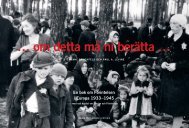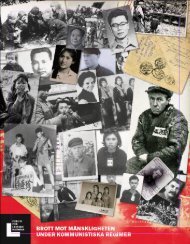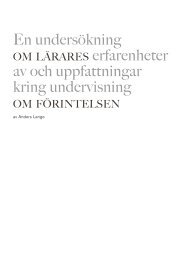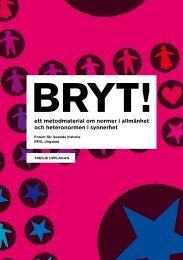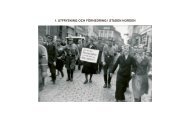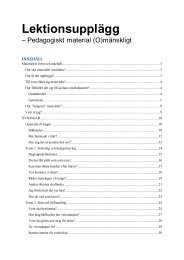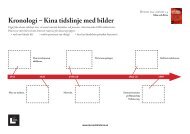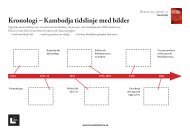Children…
Tell Ye Your Children... - Levandehistoria.se
Tell Ye Your Children... - Levandehistoria.se
- No tags were found...
Create successful ePaper yourself
Turn your PDF publications into a flip-book with our unique Google optimized e-Paper software.
The “new Germany” as seen from Sweden<br />
For generations, Sweden enjoyed close cultural, economic,<br />
political and scientific ties with Germany, so<br />
it was only natural that many Swedes closely followed<br />
developments in Hitler’s Germany. Some were<br />
appalled, while others admired and approved of the<br />
rapid changes. Swedish diplomats carefully monitored<br />
developments. In September 1935, a Swedish diplomat<br />
in Berlin reported on Nazi school policy to the Prime<br />
and Foreign Ministers in Stockholm: “It is becoming<br />
obvious in this respect, just as in many others, that Herr<br />
Hitler strives with unyielding consistency in one area<br />
after the other to implement the guidelines drawn up<br />
in his book Mein Kampf.”<br />
Most criticism of Nazi Germany came from either<br />
the labour movement or liberal circles. By and large,<br />
the right wing was also sceptical. One of the most<br />
prominent critics was Torgny Segerstedt, editor of the<br />
daily Göteborgs Handels- och Sjöfartstidning. As early as<br />
3 February 1933, he commented on the appointment<br />
of Hitler as German Reich Chancellor: “Forcing international<br />
political affairs and the international press to<br />
deal with that fellow is unforgivable. Herr Hitler is an<br />
insult.” During the war, Segerstedt continued to criticise<br />
Sweden for its passivity towards Nazism and Nazi<br />
crimes, something that annoyed not only German leaders,<br />
but also many Swedes. They accused him of risking<br />
Sweden’s “peace and neutrality”.<br />
During the 1930s, many Swedes’ admiration for<br />
Nazi Germany grew, as did their fear. In various ways,<br />
the Nazis made considerable efforts to influence Swedish<br />
55<br />
public opinion.They cultivated a “dream of the North” as<br />
a “racial” paradise, hoping that the Swedes would be their<br />
natural allies.Additionally, many Swedes were increasingly<br />
impressed by the propaganda of “Germany’s rebuilding<br />
efforts”. Even if the persecution of Jews made some<br />
people uncomfortable, there existed a widespread understanding<br />
that Germany had a particular “Jewish question”<br />
requiring a “solution”. Leading members of the Swedish<br />
Academy, such as Sven Hedin and Fredrik Böök, urged<br />
Swedes to support the “New Germany”.They considered<br />
a strong Germany led by Hitler beneficial for Sweden.<br />
Even those doubting Hitler’s goals and methods<br />
feared that Soviet Bolshevism was even more threatening.They<br />
regarded Germany’s rearmament as protection<br />
from the “threat from the East”. This attitude affected<br />
their ability, as well as their inclination, to recognise Nazi<br />
Germany’s darker sides. Once war began in 1939, Sweden’s<br />
sensitive political and geographical position meant<br />
that there was limited scope for criticism to be voiced,<br />
particularly during the period 1940-1942. Formed in<br />
December 1939, Sweden’s new coalition government<br />
for a long time struck an uneven balance between considerations<br />
for the freedom of the press, and the fear of<br />
annoying Germany by allowing criticism. In March 1942,<br />
as many as 17 newspapers were confiscated on the orders<br />
of KG Westman, Minister of Justice, after publishing testimonies<br />
of torture in Norwegian prisons. Despite such<br />
obstacles some Swedes refused to remain silent, continuing<br />
to warn society about Nazi Germany and Nazism.<br />
The fear of Communism<br />
There was a common conception in Sweden that Russia was the<br />
“traditional enemy”. The Bolshevik Revolution in 1917, followed<br />
by the formation of the Soviet Union in 1922, gave rise both<br />
to increasing alarm and growing hope among many Europeans.<br />
Initially, the organisation behind the above poster, the National<br />
Youth League of Sweden (SNU), was an independent youth<br />
organisation attached to the Conservative Party. But in 1934, it<br />
reconstituted itself into a separate party, the National League of<br />
Sweden. The party combined conservative, racist and antisemitic<br />
ideas with a demand for the abolition of democracy and the reorganisation<br />
of society according to “corporatist” principles. During<br />
the Second World War, the party, whose members were primarily<br />
from social elites, supported Nazi Germany.



